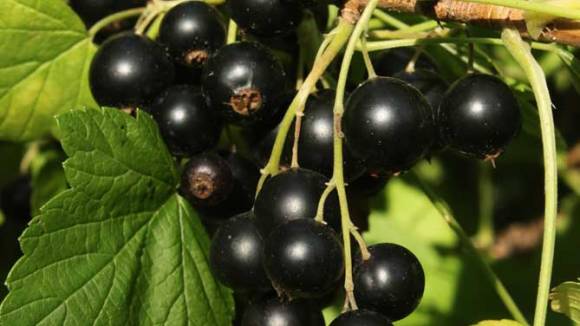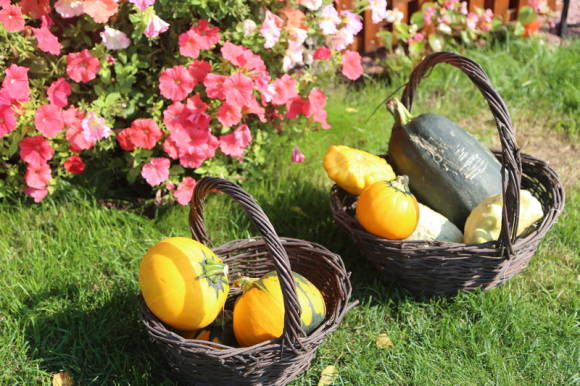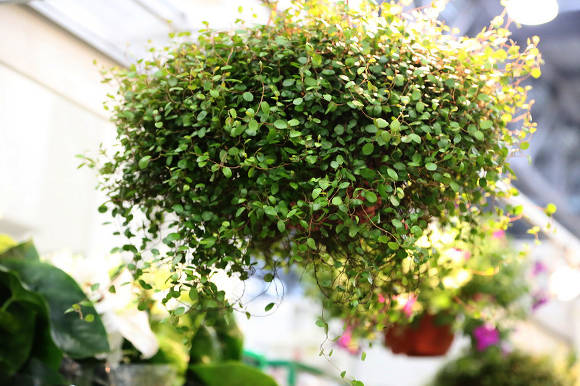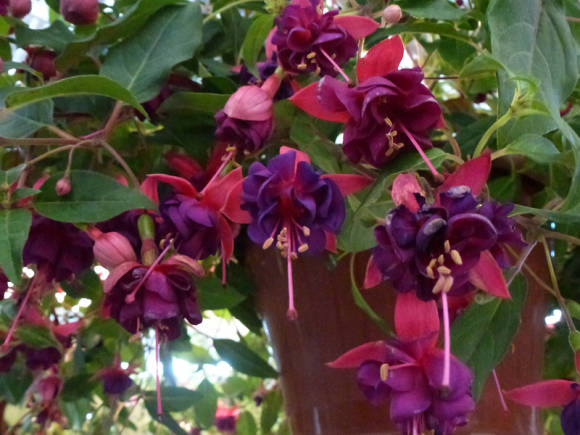Today the seed market offers us such a variety of varieties and hybrids of cucumber that even an experienced gardener can get confused. How to navigate this abundance and choose the most suitable variety for yourself?
Detailed description of varieties in articles:
Spring-summer varieties of cucumber. Parthenocarpic bundle gherkin hybrids
Spring-summer varieties of cucumber. Parthenocarpic tuberous and smooth-fruited hybrids
Spring-summer varieties of cucumber. Bee-pollinated and partially parthenocarpic tuberous hybrids
Cucumber on the balcony and more
First of all, decide where you will grow your crop.
Winter and summer varieties
There is a large group of shade-tolerant cucumber hybrids cultivated in heated greenhouses from January to July or until the end of October (F1 Marathon, F1 Relay, F1 Manul, F1 TSKHA 442, F1 Ladoga, F1 Northern Lights, F1 Olympiada, etc.).
 |  |
 |  |  |
Winter cucumbers are bee-pollinated and parthenocarpic, lumpy and smooth-fruited. The average length of the greenery is 15-25 cm; there are also long-fruited forms (with smooth green) - up to 30-35 cm long. All winter hybrids are late-ripening, characterized by strong vegetative growth, large leaves. The most popular are lumpy white-spiked hybrids with fruits of a beautiful bright green color, 15-22 cm long, large lumpy, with excellent taste, for salad purposes. Such cucumbers can be seen on store shelves in winter. All bee-pollinated hybrids must be planted with 10-15% pollinator hybrids (F1 Gladiator, F1 Hercules, F1 Ermine).
All major cucumber hybrids cultivated by gardeners and farmers in the summer are included in a group of spring-summer cucumber... Such hybrids are the fastest ripening, possessing complex disease resistance. Among them there are both parthenocarpic and bee-pollinated forms; the length of the greenery varies from 6-10 cm (gherkins) to 20 cm. This also includes beam hybrids.
Parthenocarpic and bee-pollinated varieties
Parthenocarpic forms are best suited for protected ground (greenhouses), since crop formation does not depend on pollinating insects, which pollinate plants in greenhouses worse. But parthenocarp (fruit formation without pollination) is a sign that depends on growing conditions; any stresses in plants (temperature drops, drought, excessive moisture) reduce its manifestation.
 |  |
Both parthenocarpic and partially parthenocarpic and bee-pollinated hybrids can be successfully cultivated under temporary film shelters and in open ground. Among bee-pollinated cucumbers, the most popular varieties with the female type of flowering (F1 Farmer, F1 Lord, F1 True friends, F1 Alphabet, F1 Acorn, F1 Captain, F1 Compass, F1 Teremok, etc.), they are more productive.
 |  |
But for high-quality pollination, it is necessary to sow varieties that form a large number of male flowers (barren flowers). Breeding firms put colored pollinator seeds in bags of the main bee-pollinated hybrids. These bags have a special symbol - a yellow seed in a pink square and the text "colored seeds - pollinator".
 |  |
Cold-resistant varieties
Not all cucumbers, by their biological characteristics, can tolerate the Spartan conditions of the garden. In open beds, cold-resistant varieties and hybrids are grown, adapted to the drying effect of wind and low air humidity. In addition, zelents should not lose marketability in the event of pollination.
 |  |
 |  |
F1 Anyuta, F1 Be healthy, F1 Petrel, F1 Green wave, F1 Brawler, F1 Toddler, F1 Boy with a finger, F1 Maryina Roscha, F1 Dragonfly, F1 Ant, F1 Matryoshka, F1 Grasshopper, F1 Trump card, F1 Junior lieutenant, F1 Three tankers, F1 Hit of the season, F1 Kozyrnaya karta, F1 Okhotny Ryad, F1 First class, F1 Cheetah, F1 Balalaika and parthenocarpic F1 Saltan fully meet these requirements.
 |  |

Shade-tolerant varieties
Cucumbers vary considerably in shade tolerance.In summer, you should grow cucumbers of the summer-spring ecotype, which includes most varieties for amateur gardeners. Winter cucumbers, despite their shade tolerance, are not advisable to plant in summer: they are late in terms of ripening, and are more likely to be affected by summer diseases (primarily downy mildew). All hybrids with a bundle arrangement of ovaries in the nodes are referred to as photophilous. In partial shade conditions, it is better to plant shade-tolerant hybrids (F1 Arina, F1 Moscow evenings, F1 Danila, F1 Mastak, F1 Secret of the firm).
 |  |
Some beam gherkins also have shade tolerance (F1 Maryina Roshcha, F1 Chistye Prudy, F1 Hit of the season, F1 Green wave).
 |  |
Early ripening varieties and varieties with a long fruiting period
In cucumber, there are significant varietal differences in the duration of fruiting. If you want to get a high yield in a short period, grow early ripening hybrids-sprinters (F1 Regina-Plus, F1 Cupid, F1 Bouquet, F1 Alphabet), which give most of the harvest in the first month of fruiting.
 |  |

In order to collect a large number of zelents in late summer and early autumn, cold-resistant cucumbers with a long fruiting period are planted (F1 Virenta, F1 Saltan, F1 Anyuta, F1 Farmer, F1 Lord, F1 Boy with a finger, F1 Maryina grove).
 |  |
In terms of ripening, cucumbers are divided into three groups: early ripening - the period from germination to the beginning of fruiting is less than 45 days, mid-ripening - from 45 to 50 days, late-ripening - more than 50 days. Plants begin to bear fruit at the time indicated on the seed bag if they were in favorable conditions. Any cucumbers, even the most cold-resistant, at low temperatures are significantly delayed in development, which postpones the onset of fruiting. Therefore, you should not rush to sowing or planting seedlings, carry them out at the optimal time (for central Russia, in unheated greenhouses - from May 15-20, in open ground - from June 1-5).
Salted and salad varieties
Cucumber varieties are distinguished by purpose. There are salad, canning, pickling and universal cucumbers. Salting qualities depend on the density of the skin and the content of pectin substances and sugars.
Black-thorn varieties are traditionally considered salting. But the salting qualities do not depend on the color of the pubescence, but on the density of the skin and the content of pectin substances and sugars in the fruits. Many modern varieties and hybrids have high salting qualities F1 True friends, F1 Saltan, F1 Anyuta, F1 Farmer, F1 Lord, F1 Chistye prudy, F1 Green Wave, F1 First class, F1 Acorn, F1 Dragonfly, F1 Ant, F1 Grasshopper, F1 Matryoshka, F1 Trump card, F1 Alphabet, F1 Bouquet, etc.
 |  |
Salad cucumbers have medium-sized smooth or lumpy fruits. Zelentsy has no bitterness, they have a crispy sweetish pulp and are eaten fresh (F1 Zozulya, F1 Bazar, F1 Bukhara, F1 Tamerlane, F1 Kochubey, F1 Marta, F1 Makar, etc.).

 |  |
Beam varieties
Cucumbers with a bundle arrangement of ovaries in knots are very popular among gardeners. Their main advantages are: an abundance of ovaries and zelents, gherkins, excellent pickling qualities, high productivity. In the nodes of the bundle hybrids, from three to eight or more ovaries are formed simultaneously, and up to five hundred can grow on one plant per season! Zelentsov.
 |  |
 |  |
Bunch hybrids can be parthenocarpic (F1 Maryina Roshcha, F1 Matryoshka, F1 Grasshopper, F1 Dragonfly, F1 Green Wave, F1 Kozyrnaya Karta, F1 Brawler, F1 Hit of the season, F1 Balalaika, etc.) and bee-pollinated (F1 True friends, F1 Teremok, F1 Captain, F1 Acorn, F1 Compass, F1 Alphabet, etc.).
Varieties with different types of branching
Under good branching understand the regrowth of lateral shoots from almost every node of the main stem; lateral shoots are long, requiring pinching in greenhouses. Many modern hybrids with good branching are characterized by a valuable trait - SELF-REGULATION OF BRANCHING, when a high crop load on the main stem does not allow lateral shoots to form quickly (F1 Maryina Roshcha, F1 Chistye Prudy, F1 Matryoshka, F1 Junior Lieutenant, F1 Buyan, F1 Petrel, F1 Boy with a finger, F1 Hit of the season, F1 Green wave, F1 Dragonfly, etc.). Later, when most of the crop has been harvested from the main stem, the side shoots will begin to grow faster. Thus, in the presence of self-regulation of branching, much less time is spent on pinching the lateral shoots.This is especially important if your stay in the garden is limited to weekends - such plants do not have time to overgrow too much during the working week.
 |  |
Good branching is a guarantee of long-term active fruiting (the more the cucumber branches, the longer the potential yield period). Good branching is important for cucumbers grown outdoors and under temporary cover films, as well as in greenhouses for extended harvests. Cucumbers with good branching deserve special attention in southern regions countries, since under overheating conditions weakly branching cucumbers quickly finish fruiting.
Hybrids with moderate or limited branching of lateral shoots can be many, but they are short, with shortened internodes. With this trait, a group of unique hybrids has been created (F1 Ant, F1 Grasshopper, F1 Kozyrnaya Karta, F1 Mazai, etc.), which combines a limited growth of shoots with a rather long period of fruiting. In other hybrids (F1 Cheetah), the number of lateral shoots per plant may be less, although they grow well and grow longer. Such plants are much easier to form. Hybrids with limited branching are equally successfully cultivated both in protected and in open ground.
 |  |
In a group of cucumber with weak branching includes early ripening sprinter hybrids, which give most of the harvest in the 1st month of fruiting: F1 Alphabet, F1 Cupid, F1 Regina-plus, F1 Bouquet, F1 Balalaika, etc. Lateral shoots are practically absent - i.e. are very short (up to 10-15 cm) "bouquet twigs" - with closely spaced internodes, often without leaves, they themselves stop growing. Such bouquet twigs with pouring greens look like bunches of fruits.
 |  |
After the first - the main fruiting wave, the second wave comes - from bouquet branches. Hybrids with very low branching are ideal for those situations where you need to get the maximum yield in a short time - for example, on a short summer vacation. An increased early harvest is also achieved here due to a denser planting: instead of 2.5-3 plants / m2 to 5-6 plants / m2. In hybrids of this group, the main lash is long, which provides a much higher yield compared to bush forms.
For northern regions with a short summer, late spring and early frosts, when grown in open ground and unheated greenhouses, it is advisable to select early maturing hybrids with moderate or weak branching. Hybrids with strong branching simply do not have time to give up their entire crop.
V middle zone of Russia for open ground and film, cucumbers are suitable, both with limited, and with medium and good branching. Well-branched hybrids will yield higher yields in late summer and early fall. In heated greenhouses, where the fruiting period lasts longer, preference is given to well-branched hybrids.
It is better to plant several varieties on the site, different in purpose and growing time. This will increase the period of consumption of cucumbers and the chances of getting a good harvest in different weather conditions.
Read also
- Cucumber planting care
- Why don't ovaries grow on cucumbers?
- Powdery mildew of cucumbers
- How to protect cucumbers from late spring cold weather?
Photographic materials and descriptions of varieties are provided by Manul, LLC.









